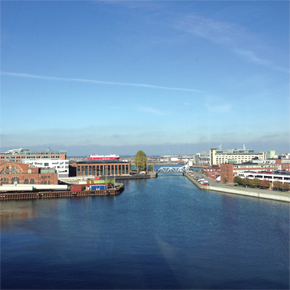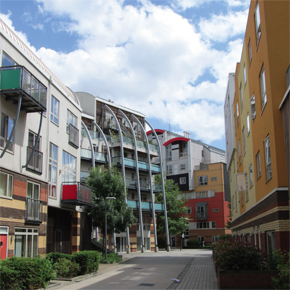
Can our cities really become healthy spaces?
Helen Pineo, associate director – cities at BRE, talks to PSB Magazine about how BREEAM accreditation can encourage a wider debate on those issues facing urban areas…
According to the United Nations Environment Programme, 70% of all global energy consumption and energy-related carbon emissions come from urban areas. These areas of high density buildings and often higher densities of population present a paradox to metropolitan planners and urban governments.
The importance of the built environment in determining health and wellbeing has been highlighted through the work of the World Health Organisation Healthy Cities Network alongside other planning and professional bodies. The epidemic of noncommunicable diseases, such as cancer and heart disease, are linked to the built environment through the shape of our urban fabric and the quality of buildings and public spaces.
BRE’s work on housing and health has shown that there is a real cost to the National Health Service from health conditions created or exacerbated by poor housing, such as respiratory illness and heart disease. The most recent estimate is that leaving vulnerable people living in the poorest 15% of England’s housing has an approximate cost to the NHS of £1.4bn per year.
Through data modelling, BRE is able to provide information to local authorities about the condition of local housing, highlighting risks and opportunities to be managed through local improvement programmes.
Over the years, BREEAM accreditation has expanded in scope to cover multiple building types, lifecycle stages and scales of development. While the breadth of issues covered has also grown, the assessment of health and wellbeing remains a key focus with most schemes having a category devoted to this issue, in addition to considering associated impacts in other categories, such as transport and pollution.
A space to breathe
The BRE sees heathy cities as urban areas where a high quality of life is available to all through the provision of housing, transport, employment and other key services. BREEAM accreditation addresses the health and wellbeing of occupants and other stakeholders in a number of ways across its criteria set. It is the most visible way that schemes tackle the impact of the built environment on health and wellbeing, but many other issues in other categories also support the achievement of healthy environments.
 BREEAM Communities, for example, addresses health and wellbeing impacts though multiple categories, such as Social and Economic Wellbeing and Transport and Movement, while the forthcoming Home Quality Mark will address the traditional health and wellbeing issues and other impacts.
BREEAM Communities, for example, addresses health and wellbeing impacts though multiple categories, such as Social and Economic Wellbeing and Transport and Movement, while the forthcoming Home Quality Mark will address the traditional health and wellbeing issues and other impacts.
This now includes an ecology strategy, issues around urban Microclimates and green infrastructures including transport and recreational spaces.
BREEAM is an holistic approach encompassing issues such as light pollution, water contamination, flood risk management, vehicle and building emissions and noise pollution. According to the World Green Building Council, research suggests that productivity improvements in offices of 8-11% are not uncommon as a result of better air quality.
All BREEAM schemes seek to promote ecological value and the provision of green space. Access to green space and nature has multiple benefits for physical and mental health and wellbeing. Cumulatively, the provision of green space and other natural environments improves air quality, reduces the urban heat island effect, creates space for social interaction and provides carbon sequestration. All of these benefits directly or indirectly support health and wellbeing.
Many BREEAM assessment issues promote active lifestyles to recognise these benefits. BREEAM Communities, for example, encourages the provision of appropriate leisure activities (gyms, swimming pools, children’s play equipment, etc.) and green space where people can exercise and enjoy the outdoors. The benefits of leading a healthy lifestyle incorporating regular exercise are also promoted through rewarding the provision of sports facilities and fitness club discounts in the BREEAM In-Use scheme.
In masterplanning projects, community consultation and participatory design take on far greater importance as the scale of the impact grows with the scale of the development. BREEAM Communities requires consultation with the community, local authority and multiple private and public stakeholders in determining how a development will be designed and what facilities will be provided.
Physical monitoring of the indoor spaces is complemented by information gathered from building occupants, via informal discussions, questionnaires and focus groups. The impact of the indoor environment on occupant’s health and wellbeing is an area of growing interest, as links have been made with outcomes such as office productivity and recovery times in hospitals.
The predicted growth of cities around the world provides opportunities to build places that will promote equality, reduce our impact on the environment and ensure economic success. Preparing for the challenges of cites in the future and managing the risks of today’s cities goes beyond smart urban scale infrastructure. BREEAM accreditation is not just a rubber stamp for sustainability, it’s a process that actively encourages a wider debate amongst urban planners, the political establishment and, yes, even the person on the street.
Latest news

19th April 2024
ASSA ABLOY: Access solutions can impact sustainability performance across the full life-cycle of a building
Embedding sustainability within any organisation requires a broad, strategic perspective. Scrutiny should include the physical infrastructure itself: According to the IEA, buildings consume around 30% of global energy*. ASSA ABLOY has more…
Posted in Access Control & Door Entry Systems, Architectural Ironmongery, Articles, Building Industry News, Building Products & Structures, Building Regulations & Accreditations, Building Services, Case Studies, Doors, Facility Management & Building Services, Information Technology, Research & Materials Testing, Retrofit & Renovation, Security and Fire Protection, Sustainability & Energy Efficiency, Video of the Week
19th April 2024
British weather doesn't dampen spirit for new HMG Garden Paint
Despite one of the wettest starts to the year on record, customers are starting to plan for brighter days with HydroPro Garden Paint from HMG Paints.
Posted in Articles, Building Industry News, Building Products & Structures, Garden, Innovations & New Products, Paints, Paints, Coatings & Finishes, Restoration & Refurbishment, Retrofit & Renovation, Site Preparation, Sustainability & Energy Efficiency, Waste Management & Recycling
18th April 2024
Abloy UK showcases new digital portfolio at The Security Event 2024
Abloy UK is set to unveil its latest line-up of access control systems at The Security Event 2024, welcoming guests to explore its cutting-edge electromechanical and digital solutions on stand 5/F50.
Posted in Access Control & Door Entry Systems, Architectural Ironmongery, Articles, Building Industry Events, Building Industry News, Building Products & Structures, Building Services, Doors, Exhibitions and Conferences, Facility Management & Building Services, Health & Safety, Information Technology, Retrofit & Renovation, Security and Fire Protection
18th April 2024
Strand is a Failsafe Choice for Emergency Exit and Panic Hardware
In times of emergency, you’re in safe hands with Strand Hardware. Although there are many considerations for building specification, few decisions can be as critical as selecting the right emergency exit/panic hardware.
Posted in Access Control & Door Entry Systems, Architectural Ironmongery, Articles, Building Industry News, Building Products & Structures, Building Services, Doors, Facility Management & Building Services, Health & Safety, Restoration & Refurbishment, Retrofit & Renovation, Security and Fire Protection
 Sign up:
Sign up: